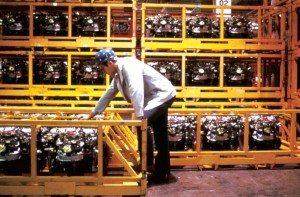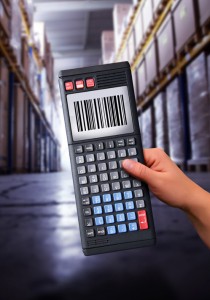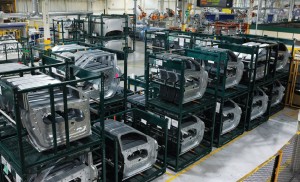Cost, safety, efficiency and control must be considered for warehouse management and materials handing equipment as Chinese manufacturers work to balance manpower and automation in the supply chain
As carmakers open new plants across China, and costs for labour and materials rise, the balance between automation and  manual labour continues to shift towards using more advanced equipment. This trend appears to be as true for state-of-the-art material handling and warehousing equipment as it is for lineside robotics. Carmakers and logistics providers are increasingly using more automated racking and picking systems, new automatic identification technologies, and are replacing forklift trucks with automatic guided vehicles (AGVs) and other storage solutions.
manual labour continues to shift towards using more advanced equipment. This trend appears to be as true for state-of-the-art material handling and warehousing equipment as it is for lineside robotics. Carmakers and logistics providers are increasingly using more automated racking and picking systems, new automatic identification technologies, and are replacing forklift trucks with automatic guided vehicles (AGVs) and other storage solutions.
However, as with any capital investment, manufacturers and logistics providers – who might own or lease the warehouse space being used – are carefully studying how much to keep manual versus automated, not least since the outlay for equipment could take a decade or more to amortise. Carmakers such as Changan Ford and Shanghai Volkswagen, along with representatives from the China Federation of Logistics and Purchasing (CFLP) are also stressing the importance of better integrating the supply chain in China over necessarily having all the latest equipment. Executives point to the benefits of using IT systems combined with robust replenishment processes to improve inventory pulls between factories and warehouses, as well as to improve visibility of what’s in the production and supply chain and in-transit inventory.
While the automotive industry is taking something of a lead in China compared with some sectors by using more automated materials handling equipment, it is not as far advanced as the retail sector, according to Ma Zengrong, general secretary of the China Automotive Logistics Association of the CFLP. Some technologies are still absent in automotive logistics that can be found in retail, such as voice recognition. However, warehouse management systems are increasingly being implemented, while RFID, after much delay, is being trialled by more automotive companies in China.
Racking and picking options
China’s racking systems in automotive logistics currently feature a mix of conventional low-tech storage methods along with some automated storage and retrieval systems (AS/RS). AS/RS systems have some limitations for in-plant and warehouse logistics, however, particularly in that they are used mostly for standard loads, which means irregular items such as chassis and bumpers do not fit. Although more AS/RS systems have been installed recently in the country, overall they are not a common sight in the Chinese automotive industry.

Ma says that these systems tend to be added to production and storage facilities following a fast growth at a plant. “The idea of AS/RS here has largely come from rapidly growing production capacity when the existing warehouse is not large enough, and then it has to be modified for AS/RS,” he says.
Shen also points to hesitance from providers to invest in AS/RS installations. It takes a long time to achieve returns, while providers usually work in relatively short-term contracts with manufacturers.
One objective of using AS/RS systems is to reduce the use of forklift trucks. Forklifts are necessary for stacking and retrieving pallets but represent not only further investment for companies but also potential danger on the warehouse floor and damage to parts if the trucks are misused. Logistics companies and manufacturers often try to limit forklift trucks to staging areas, relying as much as possible on AGVs whenever possible for lineside distribution, especially in new plants. Another way that companies reduce their forklift truck use is through very narrow aisle (VNA) racking systems in which pallets move automatically along tracking throughout a warehouse.
“Labour cost is one factor, but we often use these systems more for the safety side,” comments Edwin Chow, DHL’s senior director, head of business development for the automotive sector for Asia Pacific.
While China is seeing growth in this equipment for inbound logistics, Chow believes there are opportunities to use more sophisticated racking for aftermarket logistics. He says manufacturers use a considerable amount of mezzanine racking (shelves stocked several rows high) in service parts stocking systems, and advanced picking systems have yet to mature. “In aftermarket, warehouse layout design capability is an area worthy of more attention in China. Besides maximising space use, it should ensure the smooth flow of people and parts,” comments Chow.
Pick-to-light in set parts supply
Pick-to-light, a system that uses light displays to direct workers to specific stock locations, has been more widely adopted for automotive logistics in China than some other advanced materials handling technology. This paperless solution, which boosts picking rates, is increasingly being used in line-feeding processes, too. Manufacturers in China are turning more to electronic kanban systems that coordinate the planned flow of parts to the line and determine sequencing based on the most optimised order flow. Order instructions are simultaneously received at buffer zones and warehouses, and deliveries are made to lineside.
There are other processes for pulling set parts for kitting tasks. A growing trend is set-parts- supply (SPS) combined with use of pick-to-light, says Shen. The main concept in SPS is to separate the assembly of parts to the car body on the line from the task of searching, reaching and picking parts from component racks on the lineside. Parts are put on the SPS trolley and pushed to the line. Combining the process with pick-to-light adds to the automation. Instead of searching for parts as in the past, an operator following an AGV only needs to stop at a flashing light and pick.
“Now most newly opened plants consider SPS and pick-to-light on an on-going basis,” says Shen. “When labour costs were generally low, much could be achieved manually by using more people. But now it’s not just about labour costs, it is also the accuracy rate.”
Shen adds that limited space in older plants can make the system harder to use than in more spacious and well-planned newer factories.
 RFID may be cost-efficient for tracking large and expensive parts such as engines
RFID may be cost-efficient for tracking large and expensive parts such as enginesRFID, the process of automatically recording inventory through radio frequency, is not widely used in automotive logistics in China, except in some yards for finished vehicle logistics. As in many other markets, barcode systems remain dominant. The high cost of RFID tags is one limiting factor and there are also issues with metal frames blocking signals.
The cost of RFID tends to make the cutting-edge application a “bleeding-edge” one, says Changan Ford Automobile’s Tu Meiyan, who sees it as more likely to be used for some key bulky parts that are of high value, such as engines or gearboxes. “It will be more cost-efficient for use if there is a widespread rollout in China,” she adds.
However, Ma Zengrong believes the technology has a future in automotive logistics and notes that it has already been piloted in some plants.
Geodis’ Sean Shen says his company has seen RFID tags used more for logistics in other sectors, such as fashion, although it is usually limited to large warehouses and in situations where order picking is complicated. However, Shen sees potential for RFID to be used in returnable container management. “[Returnable containers] often cost hundreds of millions in investment, and it’s a headache for OEMs when those returnable empty bins keep getting lost in the loop,” he says. “If cost is not an issue, an RFID solution to that might be something to look at.”
Chow notes that the logistics industry already uses plenty of sophisticated equipment, including China-specific technology and solutions, but he sees a gap in the IT systems that manage logistics flows in plants or warehouses. “Ultimately, effective information systems are what it takes to give full play to the functions of equipment and right now there is an inadequacy in the industry, particularly in full information integration,” says Chow.
Ma makes a similar observation about systems and processes that would better integrate the workflow between warehouses and plants, along with the materials handling equipment used in both.“Technology and equipment is not necessarily the key. Rather, our focus is on integration in supply chain management,” he says.
In the best examples of an integrated warehouse and factory operation, Chow says, an OEM will not only have visibility over how many days worth of inventory is in the warehouse, but it would also have full visibility of the pipeline to the warehouse, including what material and in what quantity it will be coming in the days that follow, as well as inventory in-transit at sea, on the road and in the air.
Without the tools to see this information, manufacturers and providers have to rely on phone calls, emails and spreadsheets. “With information isolated, out-of-stock situations can be a common occurrence,” says Chow, pointing out that these situations often lead to the need to expedite freight, including expensive air freight. He notes that in recent months, there has been a large rise in air freight for vehicles of German and American brands in China following production increases. A more integrated supply chain could help reduce these incidents, he suggests.
“If warehouses and plants were connected in a better way, OEMs would achieve higher inventory visibility, while the warehouse would have better knowledge of order requirements,” says Chow.
Optimal information integration is an area of attention for domestic carmakers and third party logistics providers, says Chow, but he adds that changing IT systems is not easy. In some ways, he says, it is easier to change a set of physical facilities than to migrate from one system to another, especially when a legacy ERP system has been in use for many years.
According to Chow, a few domestic Chinese OEMs are working to stretch visibility into this logistics process, but it remains to be seen how far they will go. “Success in this area will give OEMs more control and offer significant savings,” he says, adding that some tier one suppliers have made improvements with their own suppliers.
"If warehouses and plants were connected in a better way, OEMs would achieve higher inventory visibility, while the warehouse would have better knowledge of order requirements" – Edwin Chow, DHL
Compared to building new physical infrastructure or making larger equipment investments, warehouse management systems are gaining more interest in China. “This is so for obvious reasons. Information systems bridge equipment, technology and management, and initiate changes,” says Ma.

As such, he adds, there is a growing trend for local equipment suppliers to shift to service providers with integrated equipment solutions.
Changan Ford is among those looking to better synchronise its supply chain with stronger systems. “Continuing improvement on information systems helps achieve leaner logistics,” says Tu Meiyan,the company’s director of material planning and logistics. “It does not just benefit OEMs but suppliers too. When we are able to take an integrated approach to plan our logistics through a more synchronised and accurate information platform, we reach the shared goal of reducing logistics cost.”
Ma considers collaboration between OEMs and logistics providers to be among the most important factors in integrating the automotive supply chain, but also one of the biggest challenges. “In the last decade, computer science has changed the way information is transmitted and now it also is changing the way processes flow,” he says. “Both OEMs and LSPs are expected be forward looking about the change information technology brings to logistics and manufacturing.”
With rising labour costs, Zhou Zhou, senior manager of logistics for the Ningbo plant at Shanghai Volkswagen, foresees further increases in the use of automated processes such as AS/RS and AGVs to standardise logistics operations. However, along with Tu Meiyan at Changan Ford, Zhou stresses the importance of considering the cost of automation with the scale of a plant’s production. RFID, voice recognition and pick-to-light systems are just some of many options. “We would like to consider the implementation results and economic benefits of a particular technology option within a specific business context and make a choice,” he says.
Any assessment on the balance of automated versus manual logistics processes must consider both the potential to save cost but also to reduce human errors. “The right mix means stopping at meeting the needs; especially when information systems are not adequately optimised, more automation can risk causing more waste,” says Ma.





































